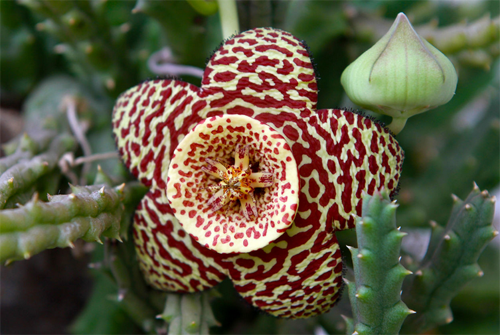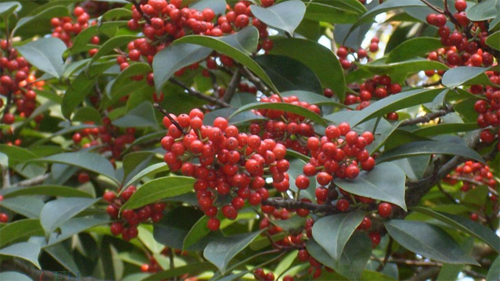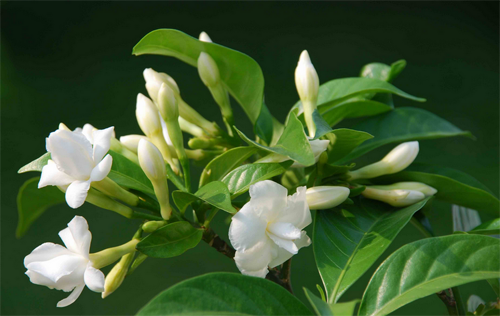The culture method of big flower rhinoceros horn is the flower poisonous
Big flower rhinoceros horn is very good-looking, just like starfish, blooming is also good-looking, but the taste is not good, there is a saying that smelly flowers, what is the breeding method of big flower rhinoceros horn? Is the rhinoceros horn flower poisonous?

Big flower rhinoceros horn (also known as starfish flower, stinky meat flower), the flower has the smell of carrion at night, is the plant of the family Ascleopodiaceae, leopard skin flower, the flower has leopard print! Like a warm and dry environment!
Brief introduction of rhinoceros horn
It is a perennial succulent herb. Plant height 20-40 cm, gray-green, stem 4-angled, densely ciliate, succulent and fleshy; flowers basal, star-shaped 5-lobed, with horizontal lines, deep purple-brown, 12-15 cm in diameter, with a special carrion-like stench.
Breeding methods of rhinoceros horn:
Pot soil requires good drainage, and pot cultivation in sandy loam is the best.
Fertilize once every 2-3 weeks during the growing period; water when the surface of the basin soil becomes dry; be sunny enough and shade about 50% in summer. The overwintering temperature is about 10 ℃, and the basin is changed once every 2 to 3 years.
1. Temperature:
Like warmth, resistant to drought. Full dormancy or semi-dormancy at high temperature in summer, overwintering temperature 50.
2. Light:
Prefer a semi-overcast environment to avoid strong direct sunlight.
3. Moisture:
The growing period of spring and autumn should be fully watered, watering should be controlled in summer, and basin soil should be kept slightly dry in winter.
4. Air
Humidity: it is required to keep the air dry and strengthen ventilation in summer.
5. Fertilization:
Rarefied liquid fertilizer was applied every half month or so in spring and autumn, and stopped in summer.
6. Change the basin:
Every spring, fertile soil rich in humus is used to change pots.
7. Reproduction:
It can be combined with changing pots in spring for ramet, and both roots and roots can survive. The sturdy and fleshy stems can also be cut in the growing season and cut in the sandy soil after a little air.
Common plants of the genus:
Wang rhinoceros horn S.gigantea
Leopard skin flower S.pulchella
Big flower rhinoceros horn fleshy stem tall and straight, shaped like rhinoceros horn, flower shape strange, like starfish, is a beautiful indoor ornamental flower.
Although they look strange, there are still many friends who like them! But people with intensive illness can't accept its flowers and can't stand it!
If there is an intensive disorder at home, you can try the big flower rhinoceros horn, the intensive disease patients will be crazy to see this. Big flower rhinoceros horn flowers are very large, and there is a bad smell, but rest assured, it is a little smelly, but no poison, you can rest assured to raise at home.
Why is succulent plant called succulent (name source) is succulent plant poisonous
Succulent plant is a kind of plant that is very popular with people at present. because of its unique appearance, it has become a popular plant form, but why is succulent plant so popular? why do people call this plant succulent? Why don't you take a look with the editor.
Why is succulent plant called succulent?
Succulent plants refer to higher plants with enlarged vegetative organs, usually with three kinds of vegetative organs such as roots, stems and leaves, and three kinds of reproductive organs such as flowers, fruits and seeds. In horticulture, it is also called succulent plant or succulent flower, but the name succulent plant is the most commonly used.
Are succulent plants poisonous?
Most succulent plants in Euphorbiaceae are poisonous. But poisonous means that the plant juice is poisonous, if you don't eat it, it will be all right. Normal furnishings must be beneficial and harmless.
What are the poisonous succulent plants?
1. Rhinoceros horn
The large flower rhinoceros horn has captured the hearts of many succulent lovers with its unique appearance. This succulent rhizome is thicker, growing upward and in a quadrangular shape. There are jagged protrusions on the surface and the color is grayish green. It gets its name because it looks very much like a rhino horn. The large rhinoceros horn flowers are larger, yellowish like starfish, and usually bloom in autumn.
As its own body contains juice, human contact will appear allergies and other symptoms, the family raised this kind of succulent relatives should not be easily touched.
2. Green Yushu
Green jade tree has many nicknames, such as single tree, iron tree, fairy stick and so on. It is a plant of Euphorbiaceae. Its florescence is from June to September and its fruiting period is from July to November. The origin of this flower is along the Mediterranean coast, where the environment is dry, so the green jade trees are mostly leafless or leafless. Because it looks like green jade, it is called green jade tree.
The whole plant of green jade tree has poisonous juice, which is very irritating. If the skin is in direct contact, it may cause skin inflammation, pustules, pain, itching, redness and swelling and other symptoms.
3. Unicorn palm
Kylin palm, like hot, sunny living conditions, the country of origin is eastern India. The ribbed fleshy stem is metamorphosed into a chicken crown or flattened fan, which is derived from the variety of Bawang whiplash.
The whole plant contains white milk, highly toxic, after human contact, there will be itching, redness and swelling and other skin allergic symptoms. Once accidentally ingested, it can cause poisoning and should see a doctor immediately.
How to grow common succulent plants
1, plant cultivation, always inseparable from three points, water, medium, light, succulent is no exception. Light is more likely to affect the state of plant growth, belonging to the advanced class. But water and medium can directly affect the life and death of plants. There are many novice growers, when they first start to plant something, they always use some soil at will and water the plants with enthusiasm and care every day. And then... There's no such thing as...
2. The soil is loose and permeable, the drainage is good, but it has a certain water retention capacity, which is neutral or slightly acidic. There are many media suitable for succulent planting, but it is very important to be sterile. The direct cause of succulent death is often decay, and only one direct cause of plant decay is fungus infection. Succulent plants in the process of transplanting, if the medium itself carries a variety of bacteria, coupled with improper care in the later stage (such as frequent watering), it is easy to cause fungus infection.
3. Therefore, aseptic or sterilized should be chosen in the initial soil selection. There are two common ways of sterilization, one is the use of fungicides such as carbendazim. The other can be sterilized by high temperature. For example, someone has stir-fried in a pan and heard that someone has baked the soil in a microwave oven. Good media, good start.
4. the principle of watering is to see dry and wet, that is, if the soil is dry, it will be watered thoroughly. If it is difficult to judge whether the soil is dry or not, you can insert a toothpick in the soil. If you want to water it, you can see the degree of dryness and wetness of the toothpick. Dry and wet is a common term in flower planting, which means watering once, and then watering the second time when the soil is almost dry. its function is to prevent diseases and insect pests caused by excessive watering of rotten roots and moisture. Of course, there is no need to be so harsh, as long as it is not watered too frequently, it generally does not cause succulent death.
5. Succulent people like the sun very much, and they grow better with a certain amount of light. In fact, it is not difficult to grow succulent plants, in fact, as long as rough cultivation! Many novices raise succulent plants because they are watered too often.
There are a lot of people who grow succulent plants, but because there are few people with succulent poisoning, it shows that normal planting will not lead to poisoning, as long as it is not eaten, it will not cause harm, and some succulent plants also have a certain edible value. So you can rest assured of breeding.
Can succulent plants bask in the sun? can succulent plants be put in the bedroom?
For succulent plants, we all know very well that they are not only exquisite and beautiful in appearance, but also better farmed than ordinary flowers. The leaves of succulent plants are thick and lovely, and they will change color more with the change of problems, but many flower friends are particularly confused. Succulent plants will be more colorful in the sun, but they are easy to sunburn. Can succulent plants bask in the sun?
Can succulent plants bask in the sun?
According to the situation, first of all, the general principle, succulent plants like the sun, so there is nothing wrong with basking in the sun, but more than 30 ℃, less than 5 ℃, the meat enters the dormant period and needs to be raised indoors.
Yulu category: can not be exposed to the sun, the morning and afternoon sun for an hour will be fine.
Elegant music dance, elegant music China, etc.: summer type, but it is best not to expose yourself to the sun.
For other succulent plants, bask in the sun as much as possible, the greater the temperature difference, the brighter the color, the thicker the powder, the cuter the shape. Spring and autumn are suitable for dew raising, that is, they are still raised outside, which is the golden period of growth, and can not be taken out in the middle of summer and winter.
Put the succulent plants in the bedroom, okay?
It can be put in the bedroom. Most plants carry out photosynthesis during the day, absorbing carbon dioxide, releasing oxygen, breathing at night, absorbing oxygen and releasing carbon dioxide. Therefore, general plants are not suitable for indoor planting and display, which will increase the content of carbon dioxide at night, while at night is often the time for people to rest in the room, which is bad for people's health. However, many cactus and succulent plants are on the contrary. In order to avoid water loss and close stomata during the day, many cactus and succulent plants open and absorb CO2 at night to form malic acid and store it in large vacuoles. During the day, CO2 is released for photosynthesis. This unique way of metabolism is called "sedum acid metabolism". So cactus and succulent plants are very suitable for indoor planting and display.
The difference between succulent indoor culture and open-air culture
Indoor farming: there is no excessive sunlight, no watering of Rain Water, no natural breeze, and the succulent plants cultivated indoors are delicate and weak.
Dew cultivation: the succulent plants raised in dew depend on nature for almost everything, so they are much better than indoor ones in terms of color and appearance. And even become very skinny.
So if you want succulent plants to grow better and thrive, it's best to move outside. But for succulent plants that have been raised indoors for a long time, it is not recommended to move outdoors. Because he has adapted to the indoor environment and has become very weak, he is not suitable for outdoor care. (weakness here refers to plant adaptability.)
What are the poisonous succulent plants?
1. Rhinoceros horn
The large flower rhinoceros horn has captured the hearts of many succulent lovers with its unique appearance. This succulent rhizome is thicker, growing upward and in a quadrangular shape. There are jagged protrusions on the surface and the color is grayish green. It gets its name because it looks very much like a rhino horn. The large rhinoceros horn flowers are larger, yellowish like starfish, and usually bloom in autumn.
As its own body contains juice, human contact will appear allergies and other symptoms, the family raised this kind of succulent relatives should not be easily touched.
2. Green Yushu
Green jade tree has many nicknames, such as single tree, iron tree, fairy stick and so on. It is a plant of Euphorbiaceae. Its florescence is from June to September and its fruiting period is from July to November. The origin of this flower is along the Mediterranean coast, where the environment is dry, so the green jade trees are mostly leafless or leafless. Because it looks like green jade, it is called green jade tree.
The whole plant of green jade tree has poisonous juice, which is very irritating. If the skin is in direct contact, it may cause skin inflammation, pustules, pain, itching, redness and swelling and other symptoms.
3. Unicorn palm
Kylin palm, like hot, sunny living conditions, the country of origin is eastern India. The ribbed fleshy stem is metamorphosed into a chicken crown or flattened fan, which is derived from the variety of Bawang whiplash.
The whole plant contains white milk, highly toxic, after human contact, there will be itching, redness and swelling and other skin allergic symptoms. Once accidentally ingested, it can cause poisoning and should see a doctor immediately.
In fact, basking in the sun for succulent plants should be viewed according to the circumstances. Although succulent plants will turn red or become more gorgeous and beautiful in the sun, they cannot be exposed to the sun. Once exposed, succulent plants will be more damaged.
- Prev

What are the planting techniques of holly?
To holly, this is quite common, and there are in many places, has made a lot of contributions to the greening of our country, what is the planting method of holly? What are the categories? Brief introduction of holly: Holly is also called northern parasite, mistletoe, frozen green, parasite and so on! It can be seen all over the country.
- Next

Is the planting method of Bermuda poisonous?
The dog tooth flower is very similar to the gardenia, and many people will admit that it is wrong. What is the planting method of such a good-looking flower? How can you plant it to look good? Is dogtooth poisonous? The planting method of Bermudagrass: potted soil choice, Bermuda also likes slightly acidic soil.
Related
- Fuxing push coffee new agricultural production and marketing class: lack of small-scale processing plants
- Jujube rice field leisure farm deep ploughing Yilan for five years to create a space for organic food and play
- Nongyu Farm-A trial of organic papaya for brave women with advanced technology
- Four points for attention in the prevention and control of diseases and insect pests of edible fungi
- How to add nutrient solution to Edible Fungi
- Is there any good way to control edible fungus mites?
- Open Inoculation Technology of Edible Fungi
- Is there any clever way to use fertilizer for edible fungus in winter?
- What agents are used to kill the pathogens of edible fungi in the mushroom shed?
- Rapid drying of Edible Fungi

